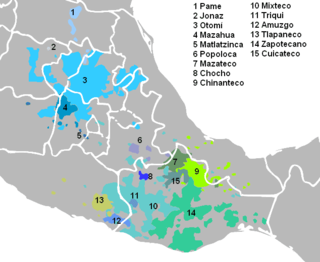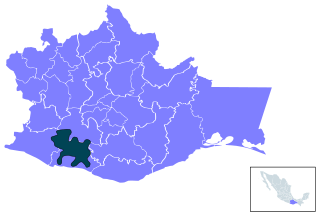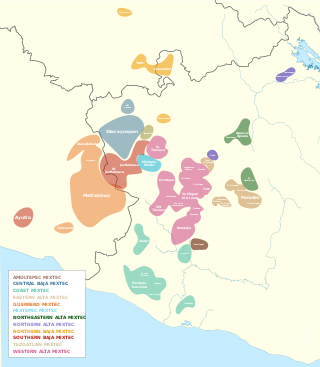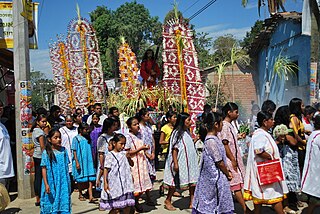Related Research Articles

The Mixtecs, or Mixtecos, are indigenous Mesoamerican peoples of Mexico inhabiting the region known as La Mixteca of Oaxaca and Puebla as well as La Montaña Region and Costa Chica Regions of the state of Guerrero. The Mixtec Culture was the main Mixtec civilization, which lasted from around 1500 BC until being conquered by the Spanish in 1523.

The Chinantec or Chinantecan languages constitute a branch of the Oto-Manguean family. Though traditionally considered a single language, Ethnologue lists 14 partially mutually unintelligible varieties of Chinantec. The languages are spoken by the indigenous Chinantec people who live in Oaxaca and Veracruz, Mexico, especially in the districts of Cuicatlán, Ixtlán de Juárez, Tuxtepec and Choapan, and in Staten Island, New York.

The Oto-Manguean or Otomanguean languages are a large family comprising several subfamilies of indigenous languages of the Americas. All of the Oto-Manguean languages that are now spoken are indigenous to Mexico, but the Manguean branch of the family, which is now extinct, was spoken as far south as Nicaragua and Costa Rica. Oto-Manguean is widely viewed as a proven language family. However, this status has been recently challenged.

Amuzgo is an Oto-Manguean language spoken in the Costa Chica region of the Mexican states of Guerrero and Oaxaca by about 44,000 speakers. Like other Oto-Manguean languages, Amuzgo is a tonal language. From syntactical point of view Amuzgo can be considered as an active language. The name Amuzgo is claimed to be a Nahuatl exonym but its meaning is shrouded in controversy; multiple proposals have been made, including 'moss-in'.

The Mixtec languages belong to the Mixtecan group of the Oto-Manguean language family. Mixtec is spoken in Mexico and is closely related to Trique and Cuicatec. The varieties of Mixtec are spoken by over half a million people. Identifying how many Mixtec languages there are in this complex dialect continuum poses challenges at the level of linguistic theory. Depending on the criteria for distinguishing dialects from languages, there may be as few as a dozen or as many as fifty-three Mixtec languages.

Chatino is a group of indigenous Mesoamerican languages. These languages are a branch of the Zapotecan family within the Oto-Manguean language family. They are natively spoken by 45,000 Chatino people, whose communities are located in the southern portion of the Mexican state of Oaxaca.

Mixtec writing originated as a logographic writing system during the Post-Classic period in Mesoamerican history. Records of genealogy, historic events, and myths are found in the pre-Columbian Mixtec codices. The arrival of Europeans in 1520 AD caused changes in form, style, and the function of the Mixtec writings. Today these codices and other Mixtec writings are used as a source of ethnographic, linguistic, and historical information for scholars, and help to preserve the identity of the Mixtec people as migration and globalization introduce new cultural influences.
Tilquiapan Zapotec is an Oto-Manguean language of the Zapotecan branch, spoken in southern Oaxaca, Mexico.

The internal classification of Mixtec is controversial. Many varieties are mutually unintelligible and by that criterion separate languages. In the 16th century, Spanish authorities recognized half a dozen lenguas comprising the Mixtec lengua. It is not clear to what extent these were distinct languages at the time. Regardless, the colonial disintegration of the Mixtec nation and resulting isolation of local communities led to the rapid diversification of local dialects into distinct languages. Below are some attempts at Mixtec classification by various scholars.

The Amuzgos are an indigenous people of Mexico. They primarily live in a region along the Guerrero/Oaxaca border, chiefly in and around four municipalities: Xochistlahuaca, Tlacoachistlahuaca and Ometepec in Guerrero, and San Pedro Amuzgos in Oaxaca. Their languages are similar to those of the Mixtec, and their territories overlap. They once dominated a larger area, from La Montaña down to the Costa Chica of Guerrero and Oaxaca, but Mixtec expansion, rule and later Spanish colonization has pushed them into the more inaccessible mountain regions and away from the coast. The Amuzgos maintain much of their language and dress and are known for their textiles, handwoven on backstrap looms with very intricate two-dimensional designs. The Amuzgo area is very poor with an economy mostly dependent on subsistence agriculture and handcraft production.
Silacayoapan is one of the more extensive Mixtec languages. It is spoken by 150,000 people in Puebla and across the border in Guerrero, as well as by emigrants to the United States.
Sindihui Mixtec is a nearly extinct Mixtec language spoken in the town of Santa Maria Sindihui in Oaxaca. It is not close to other varieties of Mixtec. It is only spoken by older adults.
Tilantongo (Diuxi-Tilantongo) Mixtec is a Mixtec language of Oaxaca. It is not close to other varieties of Mixtec. Numbers are declining due to emigration to the United States.
Atatláhuca–San Miguel Mixtec is a diverse Mixtec language of Oaxaca.
Cuyamecalco Mixtec is a Mixtec language of Oaxaca spoken in Cuyamecalco, San Miguel Santa Flor, and Santa Ana Cuauhtémoc. Egland & Bartholomew had found Cuauhtémoc to be more intelligible with Coatzospan Mixtec, which in any case is close to Cuyamecalco.
Coatzospan Mixtec is a Mixtec language of Oaxaca spoken in the town of San Juan Coatzospan.
Estetla Mixtec is a diverse Mixtec language of Oaxaca.
Ñumí Mixtec is a diverse Mixtec language of Oaxaca. It may be closest to Peñasco Mixtec.
Mixtepec Mixtec is a Mixtec language that is spoken in the lower Mixteca region. Mixtec language is largely spoken in the area of San Juan Mixtepec, district of Juxtlahuaca, state of Oaxaca. However, the language is also spoken in other areas including Tlaxiaco, San Quintín Baja California, Santa María California, and Oregon. In 2004, it was reported that approximately 12,000 people spoke the Mixtepec Mixtec language. While most speakers of the language refer to it as 'sa'an ntavi' meaning 'language of the poor' or 'poor people's language,' others refer to it as 'sa'an save' which means 'rain language.' It is not closely related to other varieties of Mixtec.
Cuatzoquitengo Mixtec is a possible Mixtec language of Guerrero.
References
- ↑ Egland & Bartholomew (1983) La Inteligibilidad Interdialectal en México